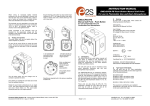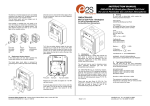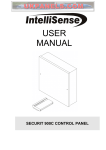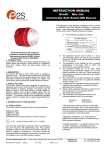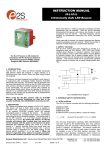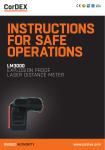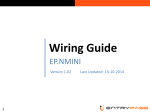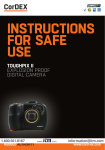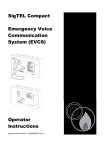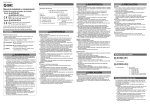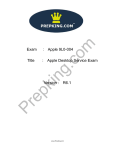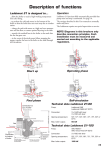Download A version installation
Transcript
INSTRUCTION MANUAL BExCP3A-BG Break glass Manual Call Point For use in Flammable Gas and Dust Atmospheres The call point switch will now change over it’s contacts to operate the alarm. Once testing is complete the unit needs to be reset, the test key is rotated back anticlockwise by an angle of 60º back to its original position. The glass element should now raise up so it is level again in the viewable window. BExCP3A-BG Zone 1 Manual Call Point - Breakglass For use in Flammable Gas and Zone 2 Combustible Dust Atmospheres. 2) Marking All units have a rating label, which carries the following important information:- Explosive gas air mixture likely to occur in normal operation. Unit Type No.: BExCP3A-BG Manual Call Point Explosive gas air mixture not likely to occur, and if it does, it will only exist for a short time. Input Voltage: AC voltage 250V Max Current 5.0A Max DC voltage 50V Max Current 1.0A Max Code: Ex e d IIC T6 Gb Ex t IIIC T60 ºC Db IP66 –40ºC <= Ta <= +55ºC 1. Insert test Key rotate clockwise 60º 2. Hold in position during test 3. Rotate back anticlockwise to reset 9) Replacement of glass element If the break glass unit has been operated the broken glass element can be quickly replaced. Certificate No.: SIRA 09ATEX3286X IECEx SIR 09.0121X To fit the new glass element rotate the top cam clockwise by an angle of 50º (use a 6mm Allen key) this will than allow the glass to fit back into the pocket it sits in, resting on the pivot point and test cam, release the top cam to rest on the top of the glass element. The break glass cover plate is removed by unscrewing the 4 off M4 cap head screws attaching it. Epsilon x: II 2GD CE Marking Notified body No. 0518 Year/Serial No. i.e. 09/1CP3ABG000001 1) Introduction The BExCP3A-BG is a break glass manual call point which is certified to the European and International Gas and Dust standards. The unit meets the requirements of the ATEX directive 94/9/EC and IECEx scheme. The call point can be used in hazardous areas where potentially flammable gas and dust atmospheres may be present. Pivot point Test Cam Top Cam (rotate) Replace the cover plate and tighten the 4 off M4 cap head screws. Ensure the glass element is free to move under the cover plate. This can be done by running through the units test operation. See section 8 of this instruction manual. Once cover is removed the broken glass will be free to be removed, clean out any other fragments of glass carefully European Safety Systems Ltd. Impress House, Mansell Road, Acton, London W3 7QH Document D150-00-001-IS Issue 1 06-06-12 The BExCP3A-BG has no monitoring resistors. The units are Group II, EPL (equipment protection level) Gb. The equipment is certified ‘Ex e d IIC T6 Gb’ and as such may be used in Zones 1 and 2 with flammable gases and vapours with gas groups IIA, IIB & IIC and temperature classes T1, T2, T3, T4, T5 and T6. These units are also Group III, EPL Db. The equipment is certified ‘Ex t IIIC T60ºC Db’ and as such may be used in Zones 21 and 22 for combustible dusts groups IIIA, IIIB & IIIC. Sheet 1 of 2 WARNING - DO NOT OPEN WHEN AN EXPLOSIVE ATMOSPHERE MAY BE PRESENT 3) Type Approval Standards The beacon has an EC Type examination certificate issued by SIRA and have been approved to the following standards:IEC 60079-0:2007 EN 60079-1:2004 / IEC 60079-1:2003 EN 60079-7:2007 / IEC 60079-7:2006 IEC 60079-18:2009 EN 61241-1:2004 / IEC 61241-1:2004 The equipment is certified for use in ambient temperatures in the range -40oC to +55oC and shall not be used outside this range. 4) Installation Requirements Installation of this equipment shall only be carried out by suitably trained personnel in accordance with the applicable code of practice e.g. [email protected] Tel: +44 (0)208 743 8880 www.e2s.com Fax +44 (0)208 740 4200 IEC 60079-14/EN 60079-14 and IEC 61241-14/EN 61241-14. It is recommended that a cable crimp lug is used on the earth wires. The internal earth wire is placed under a earth clamp which will stop the cable twisting. This is secured by an M4 screw and spring washer. The external earth lug should be located between the two M5 washers provided and securely locked down with the M5 spring washer and two locknuts. 9) Repair of this equipment shall only be carried out by the manufacturer or in accordance with the applicable code of practice e.g. IEC 60079-19/EN 60079-19. 10) The certification of this equipment relies on the following materials used in its construction: Enclosure: Aluminium Pressure Die Cast Body LM6 Unit in ‘Standby condition’ unoperated Terminal +(1) & (3) Terminal +(4) & (6) switch contacts closed Terminals+ (1) &- (2) Terminals +(4) & -(5) switch contacts open Through enclosure mechanism: Plastic Nylon Zytel Injection Moulded Sealing of enclosure and mechanism: O-ring Acrylonitrile-Butadiene Rubber Potting Compound of resistors where used: Epoxy Resin If the equipment is likely to come into contact with aggressive substances, then it is the responsibility of the user to take suitable precautions that prevent it from being adversely affected, thus ensuring that the type of protection is not compromised. View of base unit showing fixing centres. To gain access to the mounting holes in the base the front cover must be removed. This is achieved by removing the 4 off M4 cap head bolts holding on the cover. Internal Earth terminal External Earth Stud Unit in ‘Operated condition’ (broken glass) microswitch contacts changed over Terminal +(1) & (3) Terminal +(4) & (6) switch contacts open Terminals +(1) & -(2) Terminals +(4) & -(5) switch contacts closed When wiring to Increased Safety terminal enclosures, you are only permitted to connect one wire into each way on the terminal block, unless a pair of wires are crimped into a suitable ferrule. Ex e terminal block 7) “Aggressive substances” - e.g. acidic liquids or gases that may attack metals, or solvents that may affect polymeric materials. Cable connections There are 3 off cable entries for M20x1.5 Ex e approved cable glands or stopping plugs “Suitable precautions” - e.g. regular checks as part of routine inspections or establishing from the material’s data sheet that it is resistant to specific chemicals. 8) Testing unit operation The break glass unit can be tested without the need to break/replace the frangible glass element. A test key (7mm Allen key) is used to mechanically drop the glass down activating the switch. The unit can be wired in a number of different ways depending whether normally open or normally closed contacts are required. Refer to certificates SIRA 09ATEX3286X and IECEx SIR 09.0121X for special conditions of safe use. 5) Call Point Location and Mounting The location of the call point should enable ease of access for operation and testing. The unit should be mounted using the 4 off fixing holes which will accept up to M4 sized fixings. Once the screws are removed the cover will hang down out of the way to gain access to the Ex e terminal block, the internal earth terminal and mounting hole recesses. 6) Earthing The unit has both internal and external earth terminals. European Safety Systems Ltd. Impress House, Mansell Road, Acton, London W3 7QH Document D150-00-001-IS Issue 1 06-06-12 Unit in ‘Standby condition’ unoperated Terminal +(2,3) & (6) switch contacts closed Terminals +(2,3) & -(4,5) switch contacts open Sheet 2 of 2 Unit in ‘Operated condition’ (broken glass) microswitch contacts changed over Terminal +(2,3) & (6) switch contacts open Terminals +(2,3) & -(4,5) switch contacts closed The test key is inserted in the test cam and rotated clockwise by an angle of 60º the glass element will visibly drop down in the viewable window. [email protected] Tel: +44 (0)208 743 8880 www.e2s.com Fax +44 (0)208 740 4200 EC DECLARATION OF CONFORMITY Manufacturer: European Safety Systems Ltd. Impress House, Mansell Road, Acton London, W3 7QH, UK Equipment Type: BExCP3A-BG, BExCP3A-PB, BExCP3A-PT BExCP3B-BG, BExCP3B-PB, BExCP3B-PT Directive 94/9/EC: Electrical and Mechanical equipment for use in explosive atmospheres (ATEX) Notified Body for EC type Examination: Sira Certification Service Notified Body No.: 0518 Rake Lane, Eccleston, Chester CH4 9JN, UK EC-type Examination Certificate: SIRA 09ATEX3286X Notified Body for Quality Assurance Notification: Sira Certification Service Notified Body No.: 0518 Rake Lane, Eccleston, Chester CH4 9JN, UK Quality Assurance Notification: SIRA 05 ATEX M342 Provisions fulfilled by the equipment: II 2 GD Ex e d IIC T6 Gb Ex t IIIC T60 °C Db (-40 °C ≤ Ta ≤ +55 °C) or II 2 GD Ex e d mb IIC T4 Gb Ex t IIIC T70 °C Db (-40 °C ≤ Ta ≤ +50 °C) Standards applied: IEC 60079-0:2007 EN 60079-1:2004 EN 60079-7:2007 IEC 60079-18:2009 EN 61241-1:2004 Directive 2004/108/EC: Electromagnetic Compatibility Directive (EMC) Standards applied: EN 61000-6-1:2007 EN 61000-6-2:2005 EN 61000-6-3:2007 EN 61000-6-4:2007 The standards EN 60079-1:2004, EN 61241-0:2006 and EN 61241-1:2004 are no longer harmonized. The requirements of these standards have been checked against the harmonized standards EN 60079-1:2007, EN 60079-0:2009 and EN 60079-31:2009 and there were no major technical changes affecting the latest technical knowledge for the products listed above. Content of IEC 60079-0:2007 is identical to harmonized standard EN 60079-0:2009, content of IEC 6007918:2009 is identical to harmonized standard EN60079-18:2009. On behalf of European Safety Systems Ltd., I declare that, on the date the equipment accompanied by this declaration is placed on the market, the equipment conforms with all technical and regulatory requirements of the above listed directives. Martin Streetz Quality Assurance Manager Telephone: +44 (0)20 8743 8880 Facsimile: +44 (0)20 8740 4200 E-mail: [email protected] www.e2s.com Date and Place of Issue: London, 04/07/2012 Document No: DC-007-Issue_D European Safety Systems Ltd Company Registration No. 2763350 Registered Office: Impress House Mansell Road, London, UK, W3 7QH, UK



